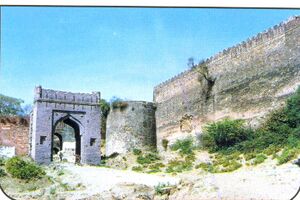Mandsaur fort
| Author of this article is Laxman Burdak लक्ष्मण बुरड़क |

Mandsaur Fort, also known as Dashpur Fort, is situated in Mandsaur city in Mandsaur district in Madhya Pradesh state of India. [1]
Strategically important
The Mandsaur city is situated on the border of Malwa and Mewar and as such is strategically very important. After the attack of Timur, the Delhi Sultanate became weak. Dilawar Khan Ghauri was governor of the Malwa province of central India during the decline of the Delhi Sultanate. Dilawar Khan declared himself Sultan of Malwa in 1401, and passed the kingdom to his son Hoshang Shah upon his death. Thus he had practically come to Mandu in 1401 as the first King of Malwa. Dilawar had also shifted the capital from Dhar to Mandu, renaming it Shadiabad, the city of joy. The successor of Dilawar Khan Gauri was Hushang Shah Gori (1405-1435), who constructed fort at strategically important Mandsaur city to strengthen his north-west boundary. [2] He is also remembered for his wonderful taste in architecture. It was he who made Mandu one of the most impregnable forts of India. The Sisodia rulers of Mewar by this time were becoming strong. Mandsaur fort was mainly associated with Mandu rulers. [3]
History
In 1519 Rana Sanga occupied the fort and appointed Ashokmal Rajput as its Kiledar. In 1535 Humayun also stayed here for few months during his Malwa expedition. During Sher Shah period Sadar Khan was appointed its Kiledar. [4] During the reign of Akbar Mandsaur got the status of sarkar. In 1733 the Malwa subedar of Mughals Sawai Jaisingh attacked the fort but was defeated by Marathas and the fort went to Marathas. [5] The historically most important event in the fort was the treaty of 1818 between Tantiya Jog senapati of Malhar Rao Holkar II and Sir John Malcum under which Malwa came in occupation of British rule. [6] [7]
The fort has twelve gates. It is surrounded by an outer wall. The south-east gate is known as Nadi Darwaja. On the side of this gate is an inscription which reveals that it was constructed by an army officer Mukbil Khan in 1490 during the tenure of Giyas Shah (1469-1500).
Bandhu Varma rule
Bandhu Varma was contemporary of Kumargupta I and Samudragupta. He was ruler of Mandsaur before Huna victory of Yashodharman. There is a inscription about Bandhu Varma at Mandsaur. The silk workers had constructed Sun temple here which was repaired by Bandhu Varma in samvat 530 (473 AD). This indicates that he was present there till 473 AD. After Bandhuvarma the ruler of Mandsaur was Vishnuvardhan who erected a pillar of victory at Bayana due to which Bayana’s name became Vijaygarh. Vishnuvardhan and Yasodharman assumed the title of Samrat after they occupied the territories of Bandhuvarma. It is also mentioned that Vishnuvardha had assumed the title of ‘Maharajadhiraja’ or Emperor. [8]
Use at present
The Fort premises are now-a-days used as office by collector, District Judge and other Govt officers. There are two gardens in which there is a pillar of torandwar. It is believed to be pillar of Surya Mandir of the inscription of Bandhu Varma. There is a Shiva statue also in the garden. [9]
References
- ↑ Usha Agarwal:Mandsaur Zile ke Puratatvik samarakon ki paryatan ki drishti se sansadhaniyata - Ek Adhyayan, Chrag Prakashan Udaipur, 2007, p. 18
- ↑ Sikandar bin Mahmud:Mirat-e-Sikandar, p. 113
- ↑ Usha Agarwal:Mandsaur Zile ke Puratatvik samarakon ki paryatan ki drishti se sansadhaniyata - Ek Adhyayan, Chrag Prakashan Udaipur, 2007, p. 18
- ↑ H.Mikal Brown (Ed): Gwalior Today, 180
- ↑ Raghuvir Singh:Madhyakalin Mandsaur mien huee Bharatiy Itihas ki kuchh nirnayak ghatnaen, p. 12
- ↑ Mandsaur district gazetteer, p. 42
- ↑ Usha Agarwal:Mandsaur Zile ke Puratatvik samarakon ki paryatan ki drishti se sansadhaniyata - Ek Adhyayan, Chrag Prakashan Udaipur, 2007, p. 19
- ↑ Thakur Deshraj: Jat Itihas (Hindi), Maharaja Suraj Mal Smarak Shiksha Sansthan, Delhi, 1934, p. 710
- ↑ Usha Agarwal:Mandsaur Zile ke Puratatvik samarakon ki paryatan ki drishti se sansadhaniyata - Ek Adhyayan, Chrag Prakashan Udaipur, 2007, p. 19
Back to Jat Monuments

